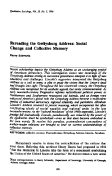Primary, Secondary, & Tertiary Sources
Information sources often are categorized as primary sources, secondary sources, or tertiary sources according to their originality and/or their proximity to the source or origin of their subject matter; however, the boundaries between these categories are sometimes fuzzy and may differ from discipline to discipline.
Furthermore, the primary, secondary, and tertiary distinctions are subjective and contextual, with the categorization of any single information source often shifting according to the context in which it is being used or studied. Regardless, a basic understanding of these three categories of information sources will be useful as you outline your research process.
Primary Sources
Primary sources are characterized by the information they convey and their relationship to the research question in that they have not been filtered through interpretation or evaluation. Rather, the interpretation and evaluation of primary sources serves as the basis for other research, often presented through secondary and, in a more general sense, teritary sources. Primary sources typically are created at the beginning of the information cycle.
What qualifies as a primary source varies from discipline to discipline, but a primary source will always be "original," "new," or "close to the source/event/period" in some way. In history, documents from the period under study or written by someone who experienced or witnessed the event or period under study are considered primary sources; diaries, journals, letters, speeches, interviews, and newspaper articles from the period may qualify as primary sources, as can memoirs and interviews written at a later date, so long as the author/interviewee experienced the period or event under study. In the sciences, a primary source is the original publication of a scientist's research (data, research/study results, theories, etc...). In the history of ideas or intellectual theory, the primary sources are the documents (books, essays, articles, letters) written by scholars, experts, intellectuals, or theorists. In disciplines such as anthropology, physical objects - photographs, jewelry, weapons, coins, paintings or buildings - are ofen considered to be primary sources. In literature and philosophy the primary document is the text you are consulting or writing about, while works of art serve as the primary sources in art history.
For more detailed information about primary sources, see the EKU Libraries Primary Sources Subject Guide or the EKU Libraries Special Collections and Archives handout about Primary and Secondary Sources.
You can also find a link to the EKU Libraries Primary Sources Subject Guide on Find Information.
Secondary Sources
Secondary sources present the analysis, synthesis, interpretation, or evaluation of primary sources, adding commentary to primary sources in the context of the particular information, idea, event, or period under study. Often secondary sources not only analyze, interpret, or evaluate primary sources, but also use them to support an argument or to persuade their audience. Secondary sources are written for professional or scholarly audiences, and - sometimes in conjunction with primary sources - are the types of sources most instructors expect you to rely on for your own work, especially scholarly, peer-reviewed secondary sources. Secondary sources begin to appear six months to a year into the information cycle, and may continue to appear for many years.
Visit Find Information for help finding and accessing scholarly and peer-reviewed secondary sources through EKU Libraries.
Tertiary Sources
Tertiary sources are the furthest removed from the origin of an event, idea, or period. While secondary sources are the interpretation and evaluation of primary sources, tertiary sources are essentially summaries or collections of primary and/or secondary sources. In simple terms, tertiary sources distill primary and secondary sources into a format that is accessible to a general audience. Encyclopedias, textbooks, and mass-circulating publications are all considered to be tertiary sources. Tertiary sources are helpful in the beginning stages of research to get a feel for your topic, establish background information, determine the current outlook, and identify keywords and/or special terminology associated with your topic; however, you should not rely heavily on tertiary sources for anything else. Generally speaking, the bulk of your research should be primary and/or secondary sources. Tertiary sources tend to appear a few to several years into the information cycle.
Visit Find Information for help finding and accessing tertiary sources for background information on your topic through EKU Libraries.
Continue to Scholarly, Professional or Trade, & Popular Sources
Return to Determine Information Needs





